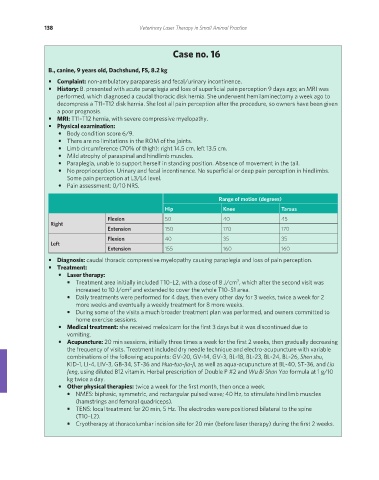Page 152 - Veterinary Laser Therapy in Small Animal Practice
P. 152
138 Veterinary Laser Therapy in Small Animal Practice
Case no. 16
B., canine, 9 years old, Dachshund, FS, 8.2 kg
• Complaint: non-ambulatory paraparesis and fecal/urinary incontinence.
• History: B. presented with acute paraplegia and loss of superficial pain perception 9 days ago; an MRI was
performed, which diagnosed a caudal thoracic disk hernia. She underwent hemilaminectomy a week ago to
decompress a T11–T12 disk hernia. She lost all pain perception after the procedure, so owners have been given
a poor prognosis.
• MRI: T11–T12 hernia, with severe compressive myelopathy.
• Physical examination:
• Body condition score 6/9.
• There are no limitations in the ROM of the joints.
• Limb circumference (70% of thigh): right 14.5 cm, left 13.5 cm.
• Mild atrophy of paraspinal and hindlimb muscles.
• Paraplegia, unable to support herself in standing position. Absence of movement in the tail.
• No proprioception. Urinary and fecal incontinence. No superficial or deep pain perception in hindlimbs.
Some pain perception at L3/L4 level.
• Pain assessment: 0/10 NRS.
Range of motion (degrees)
Hip Knee Tarsus
Flexion 50 40 45
Right
Extension 150 170 170
Flexion 40 35 35
Left
Extension 155 160 160
• Diagnosis: caudal thoracic compressive myelopathy causing paraplegia and loss of pain perception.
• Treatment:
• Laser therapy:
2
• Treatment area initially included T10–L2, with a dose of 8 J/cm , which after the second visit was
increased to 10 J/cm and extended to cover the whole T10–S1 area.
2
• Daily treatments were performed for 4 days, then every other day for 3 weeks, twice a week for 2
more weeks and eventually a weekly treatment for 8 more weeks.
• During some of the visits a much broader treatment plan was performed, and owners committed to
home exercise sessions.
• Medical treatment: she received meloxicam for the first 3 days but it was discontinued due to
vomiting.
• Acupuncture: 20 min sessions, initially three times a week for the first 2 weeks, then gradually decreasing
the frequency of visits. Treatment included dry needle technique and electro-acupuncture with variable
combinations of the following acupoints: GV-20, GV-14, GV-3, BL-18, BL-23, BL-24, BL-26, Shen shu,
KID-1, LI-4, LIV-3, GB-34, ST-36 and Hua-tuo-jia-ji, as well as aqua-acupuncture at BL-40, ST-36, and Liu
feng, using diluted B12 vitamin. Herbal prescription of Double P #2 and Wu Bi Shan Yao formula at 1 g/10
kg twice a day.
• Other physical therapies: twice a week for the first month, then once a week.
• NMES: biphasic, symmetric, and rectangular pulsed wave; 40 Hz, to stimulate hindlimb muscles
(hamstrings and femoral quadriceps).
• TENS: local treatment for 20 min, 5 Hz. The electrodes were positioned bilateral to the spine
(T10–L2).
• Cryotherapy at thoracolumbar incision site for 20 min (before laser therapy) during the first 2 weeks.
REDONDO PRINT (4-COL BLEED).indd 138 08/08/2019 09:48

